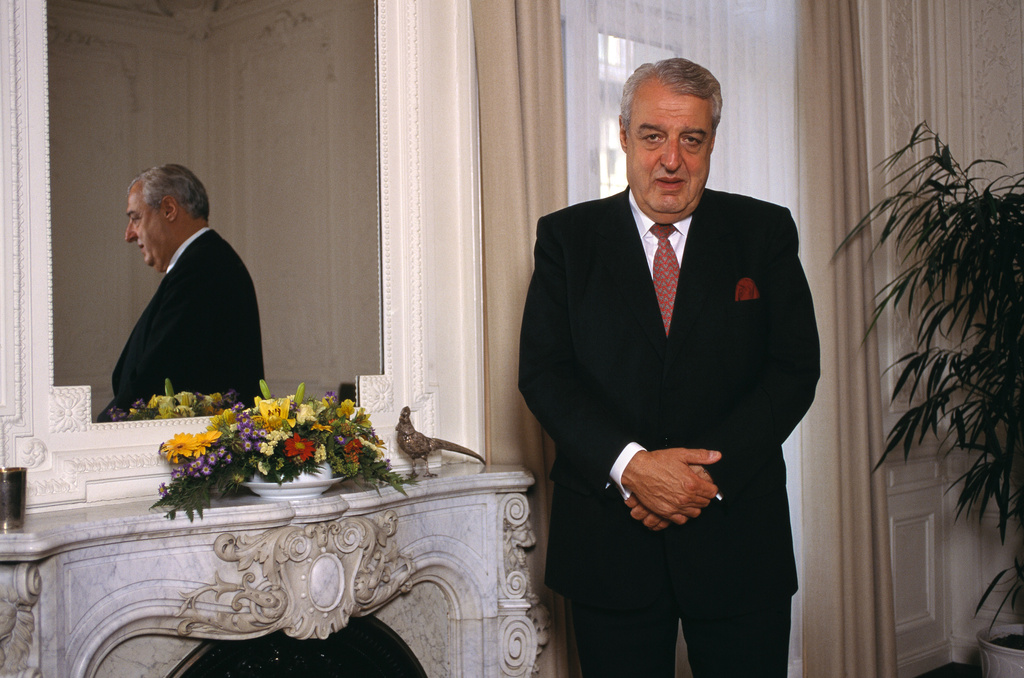New York pays homage to Swiss destructive artist

A new exhibition in Manhattan, themed around the topic of destruction, explores the lasting impact of Swiss artist Jean Tinguely.
The three-part exhibition, “Under Destruction”, at the Swiss Institute, came to life to commemorate the 50th anniversary of Tinguely’s elaborate contraption “Homage to New York”, billed at the time as a “machine that destroys itself”.
“We wanted to celebrate the crucial contribution of Tinguely’s work from today’s perspective and look at destruction as a means of expression,” Gianni Jetzer, a co-curator of the Swiss Institute exhibition, told swissinfo.ch.
To do so, Jetzer and fellow curator Chris Sharp brought together the work of 20 contemporary artists from several countries, all against the backdrop of questioning the meaning of destruction half a century after Tinguely’s first destructive extravaganza.
Tinguely, who died in 1991, did not speak of destruction but of “life very intensive” and found inspiration for “Homage to New York” in America’s largest “city-machine”.
Power of humour
Since the work took place in the space of the museum, it also paved the way for sculpture as institutional critique, he added. At the same time, the Swiss artist clearly had a lightness to his being.
“Tinguely’s sculpture helps us conceive of the word in less negative terms, in his hands “destruction” is inflected with humour, play, and planned obsolescence,” Minturn told swissinfo.ch.
Until late June, Under Destruction – initially presented at the Museum Tinguely in Basel in one large exhibition in 2010 – will unfold in three successive chapters for its incarnation at the Swiss Institute.
Chapter 1 focuses on the means of destruction. It includes “Modern Paintings” by the Czech born artist Pavel Büchler, a series of collages reconstructed from paintings discarded by art students, purchased at flea markets and rescued from trash bins.
Büchler dismantled the paintings and put the canvases in a washing machine before reassembling them into abstract, colorful mosaics.
It also includes a beat up crystal ball by Danish artists Nina Beier and Marie Lund. The artists had Jetzer and Sharp purchase a crystal ball at an occult shop near the museum and roll it to the Swiss Institute.
“From 4th Avenue to Broadway, for about 20 minutes, we kicked it back to the gallery and in the process damaged the clairvoyant quality of the crystal ball,” Jetzer said. “It was fun.”
Creative destruction
Tinguely’s “Homage to New York” was destructive at its core, but the death of the suicidal structure did not unfold exactly as planned.
The contraption featured a meteorological trial balloon, bottles, an upright piano, a go cart, a bathtub, hammers and saws, 80 bicycle wheels and many other items, much of it picked from garbage dumps in New Jersey.
When Tinguely presented his work at the sculpture garden of the Museum of Modern Art in 1960 there was plenty of billowing smoke and grating sounds as the machine collapsed in front of an audience of 250 people.
But where there’s smoke there’s fire, and when the flames grew too high for one firefighter on the scene, he dowsed the contraption with water, ending its life somewhat prematurely. But the lasting influence of Tinguely’s work clearly remains, decades after the last bits of dust from his one-off sculpture were swept from the museum’s floor.
“In a very public and a spectacular way Tinguely’s “Homage to New York” legitimised, as paradoxical as the phrase might seem, destruction as a creative strategy,” said Kent Minturn, a lecturer for art humanities at Columbia University.
Destruction on display
The second chapter of the exhibition – which opens on May 18 – is all about the act of destruction itself, and the art works on display in this section will be loudest and most violent.
US artist Liz Larner’s “Corner Basher” in part consumes the architecture in which it finds itself. The piece consists of a drive shaft mechanism that swings a ball and chain into a corner wall. An interactive sculpture, it is activated by visitors and allows them to control the speed of the bashing.
After the ball is repeatedly and mercilessly slammed, the wall is left dented and cracked; in some cases whole pieces of the wall fall off.
A video entitled “Stuhl”, one of the Swiss artist Roman Signer’s “action sculputures” in which he sets up, executes and records often violently destructive material experiments, will also be on display.
In Stuhl, a wooden chair tied to a waterwheel is dragged across the floor and then pulled completely apart by the motion of the spinning wheel.
“I simply think with material the same way a poet takes words and turns them into sentences,” Signer said.
Potential of destruction
Chapter 3, which opens on June 29, focuses on what what Jetzer describes as the potential of destruction. It will include another of Signer’s videos, called “Rampe,” which shows a Piaggio truck holding six barrels of water, which is set in motion after a candle flame burns through the rope that holds it in place.
The truck then drives up a large ramp, flips over in mid air and crashes to the ground, leaving behind a rush of liquid and trashed medal.
“Bubble Machine” by Ariel Schlesinger, an Israeli artist, will generate propane-filled soap bubbles that float down from the top of a wooden ladder onto an electric grill, where they burst into flames.
The contraption, described by Jetzer as a “very poetic Tinguely-like machine”, is powered by a battery-powered drill and held together by a series of vice grips.
Belgian artist Kris Martin’s “100 years” – created in 2004 – looks like a canon ball, and for good reason. The small lead sphere is, according to the artist, set to explode in 2104.
It’s unlikely that anyone living today will witness the destruction of Martin’s work of art when the time comes. It has Jetzer wondering: “What is a collector going to do with it in 2103, a year before it explodes?”
Tinguely would probably have had some good ideas.
Born in 1925, Jean Tinguely spent his childhood and completed his studies in Basel. He held his first exhibition in 1954 at the Galerie Arnaud in Paris.
In 1961 Tinguely married artist Niki de Saint Phalle and the two collaborated on art works.
Tinguely worked in the Dada tradition and created “kinetic art”, machines from scraps of metal, wood and other materials that moved and created new art, many destructing themselves.
He died in 1991 in Bern.

In compliance with the JTI standards
More: SWI swissinfo.ch certified by the Journalism Trust Initiative














You can find an overview of ongoing debates with our journalists here . Please join us!
If you want to start a conversation about a topic raised in this article or want to report factual errors, email us at english@swissinfo.ch.